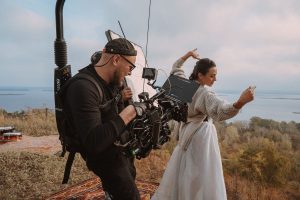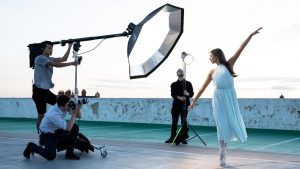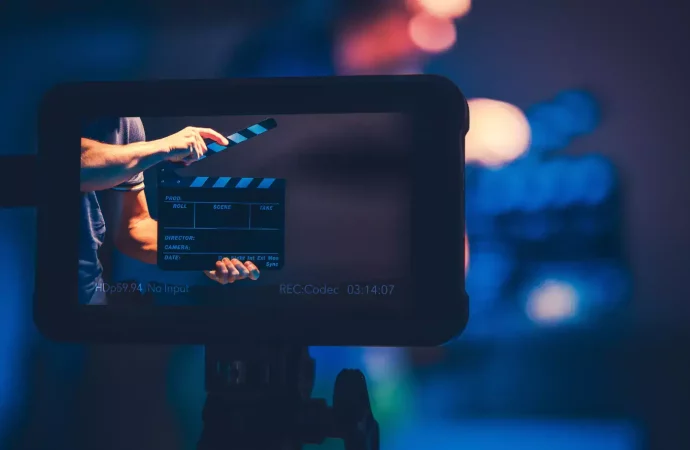Introduction The evolution of music videos has left an indelible mark on the film and TV industry, shaping the way stories are told, visuals are designed, and even how production techniques are executed. From their inception in the late 20th century to their current status as a cultural phenomenon, music videos have been a catalyst
Introduction
The evolution of music videos has left an indelible mark on the film and TV industry, shaping the way stories are told, visuals are designed, and even how production techniques are executed. From their inception in the late 20th century to their current status as a cultural phenomenon, music videos have been a catalyst for change, pushing creative boundaries and inspiring new forms of artistic expression.
The Genesis of Music Videos
Music videos began as simple promotional tools for artists and bands, but they quickly evolved into an art form of their own. The 1980s saw the rise of MTV, which catapulted music videos into the mainstream. This era marked the beginning of a symbiotic relationship between music videos and the film and TV industry, as directors and producers began to recognize the potential of this new medium.
Music videos began as a way to promote music in the late 20th century. In the 1980s, channels like MTV made them popular. Artists and directors used music videos to express ideas in bold, creative ways. Soon, these short films became a major part of pop culture.
Storytelling Innovation

Image by: Yandex.com
One of the most significant impacts of music videos on the film and TV industry is their influence on storytelling. Music videos often condense complex narratives into a few minutes, requiring directors to be innovative and efficient in their storytelling. This has inspired filmmakers and TV producers to experiment with non-linear narratives, montage sequences, and visual symbolism.
For instance, the use of quick cuts and visual metaphors in music videos has found its way into films and TV shows, allowing creators to convey emotions and themes more succinctly. This has led to a more dynamic and engaging viewing experience, where audiences are encouraged to interpret and connect with the material on a deeper level.
Music videos tell stories quickly. They often use fast cuts, striking visuals, and symbolic imagery. This has influenced how movies and TV shows tell stories. Many directors now use similar fast-paced techniques. Films like Baby Driver and shows like Euphoria use music and editing in ways inspired by music videos.
Bold Visual Styles
Music videos are known for their bold, artistic visuals. Directors are not afraid to take risks with color, lighting, and camera angles. This style has made its way into film and TV. Shows like Stranger Things and films like Drive use these eye-catching techniques. Music videos have encouraged more visual creativity across the board.
Music as a Key Element
In music videos, the song drives the visuals. This idea has changed how films and TV shows use music. Directors now pay more attention to how music shapes the story. TV shows like Atlanta and films like La La Land are built around music, much like a music video. The result is more rhythm and flow in storytelling.
Visual Aesthetics and Style

Image by: Yandex.com
The visual style of music videos has had a profound impact on the aesthetics of film and TV. Music videos are known for their bold and experimental visuals, often pushing the boundaries of what is possible with cinematography, special effects, and set design. This has influenced filmmakers and TV producers to adopt more daring and innovative visual styles in their work.
The use of color grading, stylized lighting, and creative camera angles in music videos has inspired similar techniques in film and TV, resulting in more visually striking productions. Directors like David Fincher and Spike Jonze, who started their careers in music videos, have brought their unique visual sensibilities to mainstream cinema, influencing a generation of filmmakers.
Short-Form Content for Social Media
Music videos are short and easy to share. This format is perfect for the social media age. TV and film marketing have adopted this approach. Now, teasers and trailers are often short, visually striking clips, much like music videos. Social media platforms like TikTok also use music-driven videos, blending entertainment styles.
A New Era of Audience Engagement
Because music videos are quick and catchy, they grab attention fast. Films and TV shows are adopting similar methods to engage their audiences. Social media makes it easy for fans to interact with content, from liking to sharing clips. This changes how studios market their work and connect with fans.
Production Techniques

Image by: Yandex.com
Music videos have also revolutionized production techniques in the film and TV industry. The fast-paced nature of music video production, often involving tight budgets and schedules, has led to the development of more efficient and cost-effective production methods. These techniques have been adopted by filmmakers and TV producers to streamline their own production processes.
Moreover, the collaborative nature of music video production, which often involves a diverse team of creatives, has encouraged a more inclusive and interdisciplinary approach in the film and TV industry. This has resulted in productions that are more innovative and reflective of a wider range of perspectives and experiences.
Inspiring New Talent in Film and TV
Music videos have become a launchpad for new talent in the film and TV industry. Many directors and cinematographers start their careers in music videos, where they can experiment with visuals and storytelling. This allows them to showcase their skills in a short, impactful format. From there, many transition into larger film and TV projects, bringing their innovative approaches with them. This talent pipeline ensures that fresh ideas from the music video world continue to influence mainstream visual media, keeping film and TV dynamic and evolving.
Music Videos: A Lasting Influence
Music videos have left a lasting mark on the film and TV industries. From fast-paced storytelling to bold visual experiments, their influence is everywhere. As technology and audience expectations evolve, music videos will continue to inspire the future of entertainment.
The Rise of Cross-Media Collaborations
The influence of music videos extends beyond aesthetics and production techniques. They have also facilitated cross-media collaborations, where artists, filmmakers, and TV producers come together to create unique and compelling content. These collaborations have resulted in groundbreaking projects that blur the lines between music, film, and television, offering audiences new and immersive experiences.
The Role of Music in Shaping Visual Media

Image by: Yandex.com
Music has always been integral to films and TV shows, but music videos have redefined how it shapes the visuals. Directors and producers are increasingly syncing music to visual elements more deliberately, ensuring that the music is as important as the visual narrative. This trend, often referred to as “music video logic,” emphasizes rhythm, beat, and melody in editing and scene composition.
In television, this shift is visible in series like Atlanta and Master of None, where entire sequences are built around the music, much like a music video. Films like La La Land further demonstrate this trend by using musical numbers as an essential part of storytelling, blending choreography with plot in a way reminiscent of classic music videos.
Audience Engagement and Social Media Integration

Image by: Yandex.com
Music videos are designed to be easily consumable and shareable, which has naturally extended into how film and TV are now marketed and consumed. Social media platforms like TikTok and Instagram have blurred the lines between short-form and long-form content, creating new opportunities for engagement through bite-sized visual media. TV networks and film studios increasingly release “teaser” clips and music-video-style trailers to capture audience attention in a competitive digital space.
Music videos, particularly those released by popular artists, often go viral within hours, offering a model for how entertainment content can engage global audiences instantly. This trend has carried over into film and TV marketing strategies, with visual storytelling through social media becoming a vital part of the promotional process.
Music Videos Shaping Cultural Trends
Music videos don’t just influence film and TV—they shape cultural trends. The fashion, makeup, and dance moves seen in popular music videos often become mainstream. Artists like Beyoncé and Lady Gaga have set global trends through their iconic videos. This cultural impact has inspired filmmakers and TV creators to pay closer attention to how visual styles, music, and fashion are portrayed on screen. By blending these elements, shows and movies are creating content that feels more relevant and in tune with what audiences want.
Music Videos in the Streaming Age
In the streaming age, music videos are more accessible than ever. Platforms like YouTube and Vevo allow viewers to watch music videos on demand, increasing their reach and influence. This easy access has blurred the lines between traditional films, TV shows, and music videos. Short-form video content, often with a music video-like structure, is now a common feature on streaming services and social media. The film and TV industry is taking note, using these platforms to experiment with shorter, more dynamic content that speaks to the digital generation.
The Future of Music Video Influence on Film and TV

Image by: Yandex.com
As technology continues to evolve, so too will the influence of music videos on the film and TV industry. Virtual reality (VR) and augmented reality (AR) technologies are opening new possibilities for immersive music video experiences, which in turn will inspire filmmakers to explore interactive and multi-sensory storytelling. Additionally, AI-generated visuals, already prominent in some experimental music videos, are likely to influence the visual effects used in future films and television series.
In an era where cross-media influence is increasing, music videos will continue to serve as a source of inspiration for visual media. From pushing the boundaries of what can be done with a camera to experimenting with narrative structure, music videos are not only a promotional tool but also a breeding ground for innovation that shapes the future of film and TV.
Analysis Table: Music Videos’ Influence on Film and TV
| Aspect | Music Videos | Film and TV | Impact |
| Storytelling | Fast-paced, nonlinear, symbolic | Adapted for quicker pacing and symbolic storytelling | Influences experimental narrative structures |
| Visual Aesthetics | Bold, experimental, avant-garde | Increased use of bold colors and experimental visuals | More visually distinctive projects in film and TV |
| Music Integration | Rhythm and beat drive visuals | Music plays a central role in editing and scene design | Enhanced emotional impact through synchronization |
| Audience Engagement | Designed for shareability and quick consumption | Social media integration for promotional purposes | New marketing models based on short-form visuals |
| Technology | Early adoption of VR, AR, AI | Gradual adoption in storytelling techniques | Future growth of immersive, tech-driven narratives |
Comparative Table: Traditional Film vs. Music Video-Inspired Film
| Element | Traditional Film | Music Video-Inspired Film |
| Storytelling | Linear, character-driven narratives | Nonlinear, fast-paced, visually-driven storytelling |
| Cinematography | Naturalistic, consistent with the narrative style | Bold, experimental, and rhythm-driven |
| Music Use | Background or score-driven | Integrated into the visual narrative |
| Editing | Longer takes, slower transitions | Quick cuts, synced with music and rhythm |
| Audience Engagement | Focus on cinematic experience | Designed for immediate digital/social media impact |
Conclusion
The transformative impact of music videos on the film and TV industry is undeniable. From storytelling innovation to visual aesthetics and production techniques, music videos have inspired a new wave of creativity and experimentation. As the boundaries between different forms of media continue to blur, the influence of music videos will likely persist, driving further evolution in the film and TV industry.
















